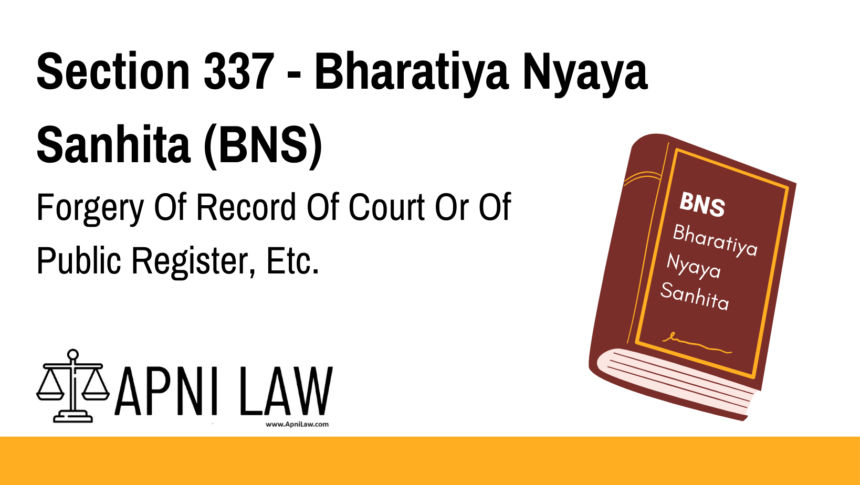Code: Section 337 BNSS
Whoever forges a document or an electronic record, purporting to be a record or
proceeding of or in a Court or an identity document issued by Government including voter
identity card or Aadhaar Card, or a register of birth, marriage or burial, or a register kept by
a public servant as such, or a certificate or document purporting to be made by a public
servant in his official capacity, or an authority to institute or defend a suit, or to take any
proceedings therein, or to confess judgment, or a power of attorney, shall be punished with
imprisonment of either description for a term which may extend to seven years, and shall also
be liable to fine.
Explanation.—For the purposes of this section, “register” includes any list, data or
record of any entries maintained in the electronic form as defined in clause (r) of sub-section (1)
of section 2 of the Information Technology Act, 2000.
Explanation of Section 337 BNSS
Section 337 criminalizes the forgery of important public records and official documents, which are critical for legal, administrative, and civic purposes. This includes:
- Court records (e.g., judgments, orders, case proceedings),
- Government-issued identity documents (e.g., Aadhaar, Voter ID),
- Official registers (e.g., birth/marriage certificates),
- Documents created by public servants (e.g., certificates, powers of attorney).
The law ensures that any manipulation, falsification, or creation of false documents in these categories is severely punished, as it can lead to significant public harm, legal disputes, and identity fraud.
Illustrations
- Forgery of Court Records:
- Example: A forges a court order to falsely claim a favorable judgment in a property dispute.
- Outcome: A commits forgery under Section 337, punishable with up to 7 years of imprisonment and a fine.
- Forgery of Identity Documents:
- Example: A forges an Aadhaar card with a fake identity to open a bank account fraudulently.
- Outcome: A commits forgery of an identity document, punishable under Section 337.
- Fake Birth Certificate:
- Example: B forges a birth certificate to falsely claim age eligibility for government employment.
- Outcome: B commits forgery of a public register, liable to imprisonment and fines.
- Forgery of Power of Attorney:
- Example: C forges a power of attorney to sell someone else’s property without permission.
- Outcome: C commits forgery under Section 337, with up to 7 years of imprisonment and fines.
- False Marriage Certificate:
- Example: D creates a fake marriage certificate to claim spousal benefits.
- Outcome: D commits forgery of an official document under Section 337.
Common Questions and Answers
1. What types of documents fall under Section 337?
It applies to court records, government-issued identity documents (like Aadhaar, Voter ID), public registers (birth, marriage, death), and official certificates made by public servants.
2. What is the punishment for forgery under Section 337?
The punishment includes imprisonment up to 7 years, a fine, or both.
3. Does this section cover electronic records?
Yes, Section 337 covers electronic records as well, as per the Information Technology Act, 2000.
4. Can a person be punished for forging a document that was not used?
Yes, even if the forged document is not used, the act of forging it with fraudulent intent is punishable under Section 337.
5. What is the difference between Section 336 and Section 337?
- Section 336: Deals with general forgery of documents with intent to deceive or commit fraud.
- Section 337: Specifically targets forgery of official documents, court records, and public registers, which have legal significance.
Conclusion
Section 337 of the Bharatiya Nyaya Sanhita (BNS) is a stringent provision aimed at combating the forgery of critical official documents. It emphasizes the importance of authenticity and integrity in legal, governmental, and public records.
The section provides severe penalties—up to 7 years of imprisonment—to deter individuals from engaging in fraudulent activities that can undermine public trust, legal procedures, and national security.
By covering both physical and electronic records, Section 337 ensures that modern methods of forgery, such as digital document manipulation, are also effectively addressed.








